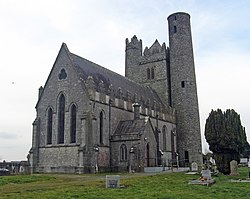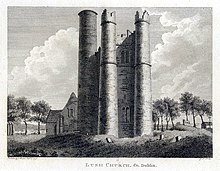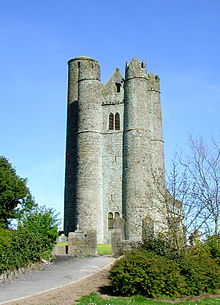Lusk
| Lusk Gaelic: Lusca | |
| County Dublin | |
|---|---|
 Church of Ireland and round tower at Lusk | |
| Location | |
| Grid reference: | R746888 |
| Location: | 53°31’34"N, 6°10’1"W |
| Data | |
| Population: | 7,022 (2011) |
| Post town: | Lusk |
| Postcode: | K45 |
| Local Government | |
| Council: | Fingal |
Lusk is a small town and parish in County Dublin, 14 miles north of Dublin city centre. The name "Lusk" is said to date back to Saint MacCullin, who founded a church there c. 450. Oral tradition suggests MacCullin may have either lived in or been buried in a cave and that the name "Lusk" derives from an old Irish word Lusca meaning 'cave' or 'underground chamber'. MacCullin died in c. 497 and his feast day was the 6th September.[1] The area was known as Bregia in pre-Christian times and is known to have been birthplace to Cú Chulainn's wife, Emer. Thus we find a 20th-century tradition among old Lusk families of naming daughters Emer.
In the 2000s, Lusk had an exploding population. The Central Statistical Office notes that 62% of all private dwellings in Lusk were built in the five years between 2001 and 2006. Census figures for the same period show a population boom from c. 2,500, to over 5,200.[2][3] During most of the 20th century, the population remained fairly static. Census returns for 1901 and 1911 show a population boom from about 300 to 600. In the early 1950s, the Survey Gazetteer of The British Isles quotes a population of 513 for the village. Due to massive emigration in the 1950s and 1960s the later population actually declined. In the mid-1950s for instance, the total number of children in the old NS, boys and girls, hovered around 120. The present NS opened in 1956 with about that number.
The railway station of Rush & Lusk is about a mile east and is shared with the coastal settlement of Rush.
History
As mentioned above the settlement has been associated with St MacCullin since c. AD 450. The place also had associations with St Maur. The ruins of St Maur's original church, or more likely its later replacement, are at the top of Whitestown hill, firmly in the parish of Rush. Lusk was plundered and burned several times in the 8th and 9th centuries by marauding Vikings, who eventually built a permanent settlement at Dubh Linn, now Dublin.
The only tangible remnant of the early Christian foundation at Lusk is the round tower. It stands 88 ft high (originally some 105 ft high) which retains its original conical cap or so it seems, as the modern trap-door onto the rooftop suggests otherwise. Inside are nine 'floors' including the basement, which are likely to be due to unrecorded 'improvements' in or after the Middle Ages. The flat-headed doorway, which originally would have been some 15 ft above the ground is now less than 3 ft above ground level. The tower either sunk or was buried some 12 ft over the centuries. The Round Tower is adjacent to a Norman square tower built against it in the 15th century. This building has three matching towers at its corners and is beautifully represented by the 18th-century picture below. The square tower holds several mediæval tombs including that of James Bermingham (1527) and the double-effigy tomb of Christopher Barnewall and his wife Marion Sherle (1589). The Church of Ireland church dates from 1847 by Joseph Welland, and was designed in an Early English Gothic style.[4]

The round tower at Lusk was built by 9th-century Christians in an attempt to foil the Vikings, who were interested not only in the easy pickings but also the inhabitants themselves as a source of slave labour. As an interesting aside, a world-famous pipe band formed in 1910 and still as strong is named the Black Raven Pipe Band. The black raven was very special to the Vikings. [See Iceland Daughter of Fire; Katharine Scherman 1976]. The entrance door to Lusk Round Tower, as with all such towers, was originally 12-16 ft above ground. Ladders were used to reach the entrance and then pulled up. (Refer to similar round towers at Glendalough, Ardmore, and Clonmacnoise.)
Lusca Irish Wine named after the Irish for Lusk, by Llewellyns Orchard,[5] is one of the few wine producers using grapes grown in Ireland.
On 26 May 2005 there was an attempted armed robbery of Lusk Post office, Main St. During this attempted robbery two gang members were shot dead by Gardaí. The total incident lasted 20 seconds. In 2007 a third gang member was given a 10-year jail sentence for his role in the deadly raid www.independent.ie.
Civic elements

Lusk Community Council Ltd (LCC) was set up to look after the village and liaise with local government and councillors.[6] LCC is a voluntary organisation whose responsibility has been to manage the Carnegie Library hall and the Old Church hall by the round tower. They also run the St Patrick’s Day parade each year.
The village accommodates many different social clubs and activities:
- Lusk United AFC soccer club[7]
- The Round Towers GAA club
- Judo club[8]
- The Black Raven pipe band[9]
- A branch of the Irish Countrywomen's Association[10]
- A kick-boxing club[11]
- Lusk AC athletics Club[12]
- A heritage group[13]
- A Tidy Towns group[14]
- A golf society[15]
- Drama School[16]
- A senior citizens group[17]
- St Vincent de Paul Society [18]
References
- ↑ Pàdraig Ó Riain, A Dictionary of Irish Saints (Dublin: Four Courts Press, 2011), p. 415.
- ↑ 2002 Saps Themes - Towns with Population of over 1,000 2002 data"
- ↑ http://census.cso.ie/sapmap2006results/Results2.aspx?Geog_Type=Towns&Geog_Code=0407C%20Lusk 2006 data
- ↑ 1847 – Church and Tower, Lusk, Co. Dublin archiseek.com
- ↑ Lusca Irish Wine
- ↑ http://www.luskparish.ie/ccouncil.html
- ↑ http://www.luskunited.yourclub.ie/
- ↑ http://users.imagine.ie/dar/index.html
- ↑ http://www.blackravenpipeband.net
- ↑ http://www.ica.ie/ICA/Your-Local-ICA/Dublin.953.1.aspx
- ↑ http://elitetkddublin.com/tag/lusk/
- ↑ http://luskathleticclub.ie/
- ↑ http://www.luskheritage.com/
- ↑ http://www.luskparish.ie/tidytowns.html
- ↑ http://www.roundtowerslusk.ie/round-towers-golf-society/
- ↑ http://www.powerdramaschool.com
- ↑ http://www.independent.ie/regionals/fingalindependent/localnotes/active-lusk-senior-citizens-keeping-busy-27799418.html
- ↑ http://www.luskparish.ie/svp.html
Outside links
| ("Wikimedia Commons" has material about County Dublin Lusk) |
